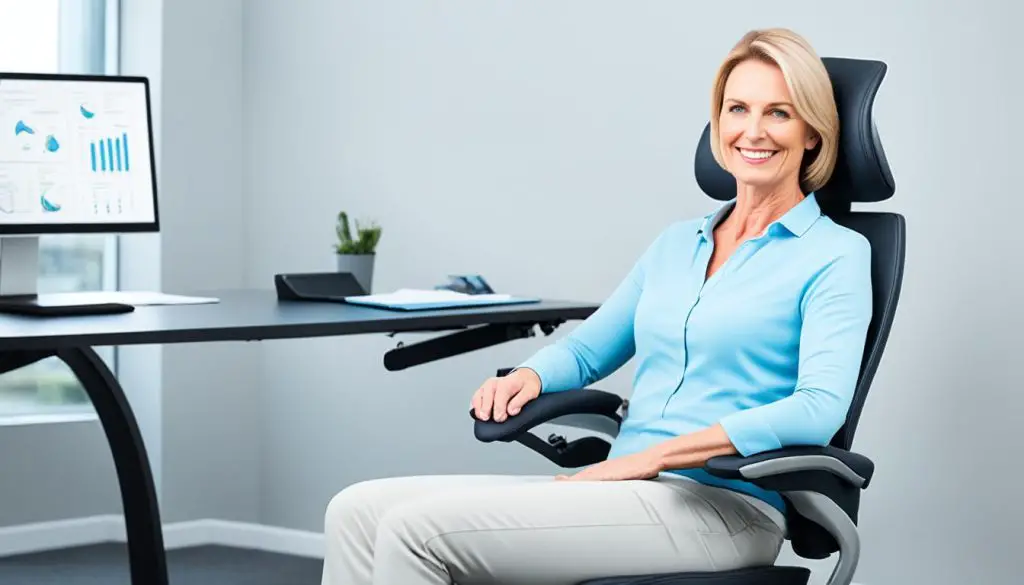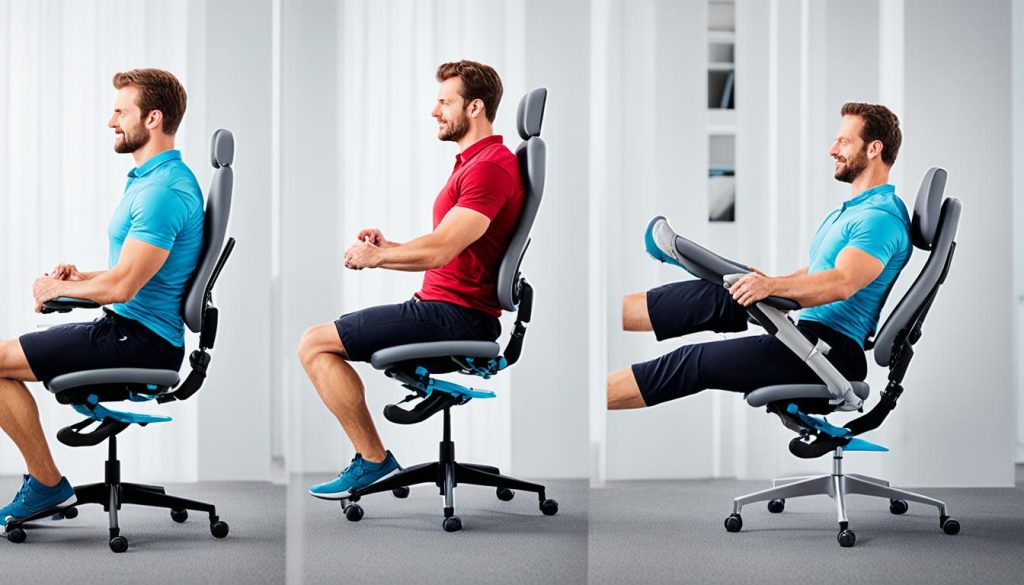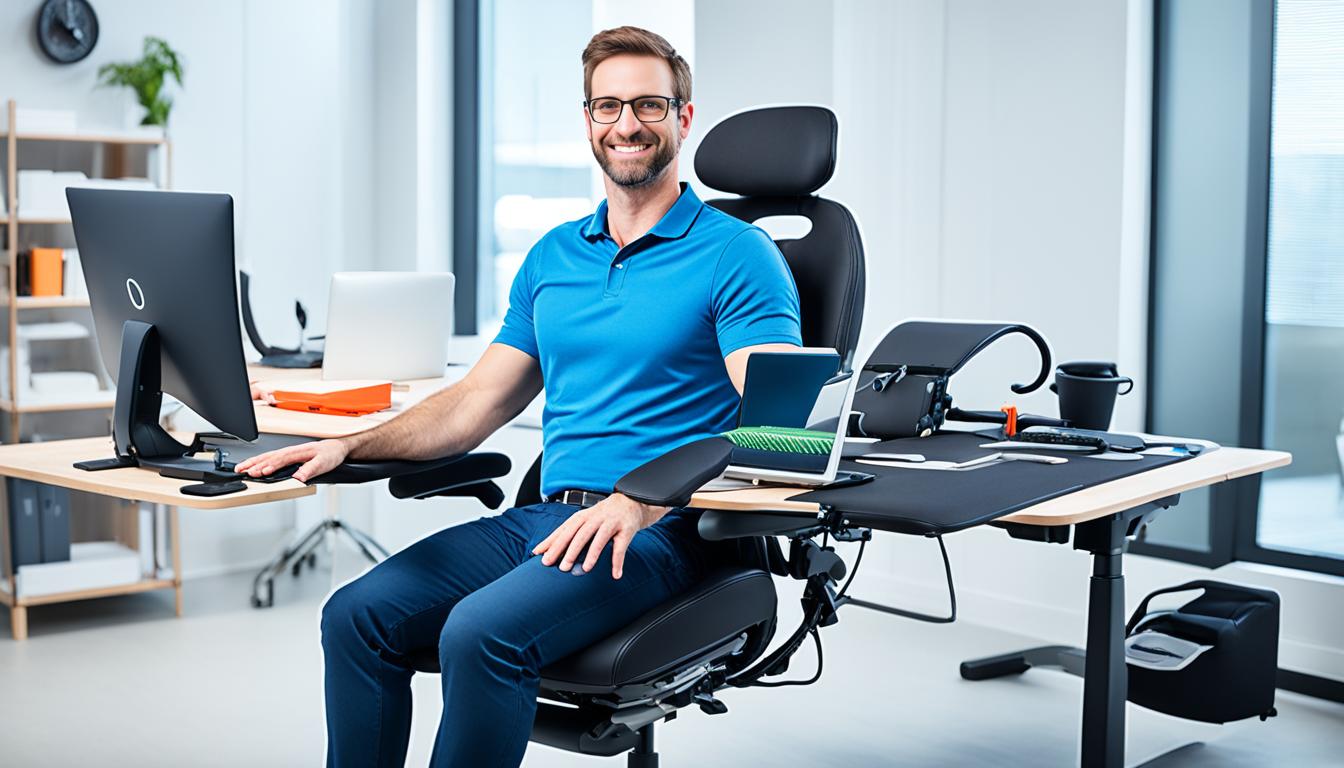As a man who spent a decade loving a woman with chronic illnesses, such as endometriosis and fibromyalgia, I have personally witnessed the impact of these conditions on a daily basis. The journey of supporting my wife through her health challenges has shaped me into the person I am today, advocating for her well-being and searching for solutions that bring her comfort. It was during this journey that I discovered my love for blogging, which has become a therapeutic outlet for me, allowing me to escape the new normal of chronic illness and share our experiences with others.
Blogging not only gives me a space to express my thoughts and emotions, but it also serves as a platform to raise awareness about the importance of ergonomic furniture in chronic illness care. I have learned firsthand how the right ergonomic solutions, such as specialized seating and workstations, can significantly improve the quality of life for individuals with chronic illnesses. Ergonomic furniture not only provides physical support and pain management, but it also promotes independence and facilitates daily activities.
Through my blog, I aim to educate others about the health benefits of ergonomic furniture in chronic illness care. I share our personal experiences and insights, highlighting the positive impact that ergonomic design has had on my wife’s comfort and overall well-being. By promoting the use of ergonomic furniture, I hope to empower individuals with chronic illnesses to seek out these solutions and create a more comfortable and supportive environment for themselves.
Moreover, blogging has also helped us secure our future financially. It has opened up opportunities for collaborations with brands that provide ergonomic solutions, allowing us to try out and review various products. These partnerships not only provide us with the necessary resources to invest in ergonomic furniture but also enable us to share our honest feedback with our readers, helping them make informed decisions about the best ergonomic solutions for their specific needs.
Join me on this journey as we explore the importance of ergonomic furniture in chronic illness care and discover the transformative power it can have on the lives of individuals and their loved ones. Together, we can embrace the new normal with chronic illness, advocate for better support and comfort, and create a future where those facing chronic illnesses can thrive.
The Facts About Ergonomic Workplace Injuries
Worker injuries and illnesses resulting from ergonomic hazards pose a significant concern in the workplace. According to the U.S. Bureau of Labor Statistics, these ergonomic workplace injuries account for nearly a third of all reported cases.
Ergonomic injuries primarily affect the body’s soft tissues, including tendons, ligaments, muscles, joints, and spinal parts. The most common ailments resulting from poor ergonomics are musculoskeletal disorders – debilitating conditions that can have long-lasting effects.
Conditions such as carpal tunnel syndrome and tendinitis are major concerns for individuals exposed to inadequate ergonomics. These injuries, if left untreated, can progress into chronic conditions that impact an individual’s quality of life. Therefore, it is crucial to address ergonomic hazards effectively to promote a safe and healthy work environment.
The Impact of Ergonomic Workplace Injuries
Ergonomic workplace injuries can have severe consequences, both for the affected individuals and the overall productivity of a workforce. Here are some key effects of such injuries:
- Decreased productivity due to reduced physical capacity
- Increased absenteeism and presenteeism
- Higher healthcare costs and insurance claims
- Prolonged recovery periods and potential long-term disability
- Reduced job satisfaction and employee morale
By acknowledging the risks and implementing proper ergonomic solutions, employers can prevent these injuries and create a safe and productive working environment for their employees.
The Prevalence of Ergonomic Workplace Injuries
Ergonomic injuries are not isolated incidents; they affect a significant number of workers across various industries. Here are some statistics on the prevalence of ergonomic workplace injuries:
| Industry | Percentage of Ergonomic Injuries |
|---|---|
| Healthcare and social assistance | 34% |
| Manufacturing | 29% |
| Retail trade | 14% |
| Construction | 11% |
These numbers highlight the need for industries to prioritize ergonomics to prevent worker injuries and promote overall well-being.
The Root Causes of Ergonomic Workplace Injuries
The root causes of ergonomic workplace injuries can be traced to furniture and equipment that lacks proper ergonomics. Objects that put unnatural pressure and stress on sensitive body parts can lead to strains and more severe injuries. Poor ergonomics in the workplace can arise from various factors, including:
- Poorly designed furniture: Furniture without proper support, adjustability, or ergonomic features can contribute to discomfort and increase the risk of injury. Examples include chairs without lumbar support, desks without adjustable height, and keyboards without wrist rests.
- Inadequate equipment: Tools and equipment that require awkward and repetitive movements can lead to musculoskeletal disorders. Scissors with uncomfortable handles or keyboards with a non-ergonomic layout are common culprits.
- Unsuitable workstations: Workstations that do not allow employees to maintain proper posture, reach necessary tools, or position their equipment appropriately can result in chronic discomfort and increased risk of injury.
- Insufficient training: Lack of education on proper ergonomics and body mechanics can lead to employees unknowingly engaging in behaviors that strain their bodies and contribute to workplace injuries.
When employees are repeatedly exposed to furniture, equipment, and workstations that do not prioritize ergonomics, the cumulative effect can result in increased risk of injury or illness. Medical practices must prioritize providing furniture and equipment that meet the specific bodily needs of their staff to prevent ergonomic workplace injuries.

How Ergonomics Enhance Productivity
An ergonomic workplace environment is essential for maximizing productivity and ensuring the well-being of your employees. By providing comfortable and healthy furniture and equipment, you create a space that supports their physical and mental health. This, in turn, allows them to focus on their tasks and perform at their best.
Chronic pain can significantly impact your employees’ performance and job satisfaction. When individuals are in pain, it’s challenging for them to concentrate on their work and maintain productivity. Investing in ergonomic furniture that alleviates chronic pain can make a world of difference. By providing supportive chairs, desks with adjustable heights, and ergonomic keyboard and mouse setups, you can help your employees work more consistently without experiencing discomfort or fatigue.
Stress and fatigue are common workplace challenges that affect worker performance. Ergonomics can play a crucial role in mitigating these issues. By offering a comfortable and well-designed workspace, you can reduce stress levels and minimize fatigue. Proper ergonomics can help employees maintain good posture, which not only prevents strain but also promotes overall well-being. An ergonomic setup also ensures that employees have access to the tools and equipment they need, improving efficiency and reducing fatigue caused by constantly searching for items or adjusting their workstation.
When employees are free from chronic pain and feel physically comfortable, their energy and passion for their work increase. Ergonomics not only enhances productivity but also fosters a positive work environment. Employees who feel supported and cared for are more likely to be engaged and motivated. By prioritizing ergonomic solutions, you invest in the well-being and success of your employees.
Remember, a productive workplace is built on the foundation of ergonomics. Empower your employees with comfortable and healthy furniture and equipment, and watch their productivity soar.
Benefits of Ergonomics in Enhancing Productivity:
- Reduces chronic pain and discomfort
- Minimizes stress and fatigue
- Improves posture and prevents strains
- Enhances focus and concentration
- Increases energy and motivation
| Furniture/Equipment | Benefits |
|---|---|
| Ergonomic chairs | Provides proper lumbar and back support, reducing back pain and improving posture |
| Adjustable desks | Allows employees to switch between sitting and standing positions, promoting blood circulation and reducing fatigue |
| Ergonomic keyboard and mouse | Reduces the risk of repetitive strain injuries and improves comfort during computer work |
| Monitor stands | Positions the screen at eye level, preventing neck and shoulder strain |
The Health Benefits of Ergonomic Furniture in Chronic Illness Care
Ergonomic furniture offers numerous health benefits in chronic illness care. Investing in ergonomic solutions can greatly improve patient comfort, support pain management, and enhance overall well-being. Let’s explore the specific health benefits that ergonomic furniture provides for individuals with chronic illnesses.
Improved Comfort and Support
Ergonomic furniture is designed to prioritize comfort and provide optimal support for individuals with chronic illnesses. Chairs with lumbar support and adjustable features allow patients to find the most comfortable positions for pain management. Ergonomic mattresses and pillows, tailored to individuals’ needs, reduce pressure points and promote better sleep quality. Enhanced comfort and support contribute to an improved quality of life for patients.
Reduced Risk of Musculoskeletal Injuries
Chronic illness care often involves extended periods of sitting or lying down. Without proper support, this can lead to musculoskeletal injuries and exacerbate existing conditions. Ergonomic seating, such as chairs with lumbar support and adjustable features, promote proper posture and reduce the risk of injuries. By providing ergonomic furniture, medical practices can create a safe and supportive environment for their patients.
Pain Management
Pain management is a crucial aspect of chronic illness care. Ergonomic furniture plays a significant role in helping patients manage their pain effectively. Chairs with adjustable features can be customized to alleviate pressure on sensitive areas and reduce discomfort. Ergonomic beds and mattresses provide optimal support and help alleviate pain during sleep. By incorporating ergonomic furniture into chronic illness care, medical practices can contribute to the overall well-being of their patients.
Increased Productivity
Ergonomic furniture not only benefits patients but also enhances the productivity of healthcare professionals. Medical providers who are comfortable and supported by ergonomic workstations experience reduced fatigue and discomfort, enabling them to focus more on providing excellent care. By investing in ergonomic solutions, medical practices can improve employee well-being, which directly translates into improved productivity and patient outcomes.
Now that we have explored the health benefits of ergonomic furniture in chronic illness care, it is evident that these solutions are invaluable for enhancing patient comfort, managing pain, and improving overall well-being. By prioritizing ergonomic furniture, medical practices can create a supportive and healing environment for individuals with chronic illnesses.

Ergonomic Solutions for Chronic Illness Comfort
When it comes to providing comfort for patients with chronic illnesses, medical practices can implement a range of ergonomic solutions that are tailored to their specific needs. These solutions not only improve patient comfort but also enhance their overall well-being. By incorporating adjustable furniture and customized support, medical professionals can effectively manage pain and promote a better quality of life for patients.
Adjustable furniture, such as beds and chairs, plays a vital role in offering maximum comfort and support for patients with chronic illnesses. It allows patients to find the most suitable positions that alleviate pain and promote pain management. By being able to adjust the height, angle, and other features of furniture, patients can customize their positions to minimize discomfort and optimize their level of comfort.
Furthermore, customized support accessories can significantly enhance the comfort of patients with chronic illnesses. Lumbar pillows, mattress toppers, and other supportive aids are designed to alleviate pressure points, which are crucial for patients who are confined to bed for extended periods. These accessories help reduce discomfort, provide added support to the body, and contribute to better sleep quality, which is essential for pain management and overall well-being.
By incorporating these ergonomic solutions into the care environment, medical professionals can create a more comfortable and supportive atmosphere for patients with chronic illnesses. This, in turn, promotes a better quality of life, reduces pain, and contributes to overall patient satisfaction.
Ergonomic Solutions for Chronic Illness Comfort
| Benefits | Ergonomic Solutions |
|---|---|
| Enhanced comfort and pain management | Adjustable beds and chairs |
| Alleviation of pressure points | Lumbar pillows and mattress toppers |
| Improved sleep quality | Customized support accessories |
| Optimized pain relief | Ergonomic furniture customization |
Ergonomic Furniture for Pain Management in Chronic Illness Care
When it comes to chronic illness care, finding effective ways to manage pain is paramount. That’s where ergonomic furniture comes in. Ergonomic furniture is specifically designed to provide support, reduce discomfort, and improve overall well-being. By incorporating ergonomic furniture into their practice, medical professionals can greatly enhance the quality of life for their patients.
One of the primary benefits of ergonomic furniture is its ability to reduce pain. Chronic pain is a common symptom for many individuals with chronic illnesses, and finding relief is crucial. Ergonomic furniture, such as chairs with proper lumbar support or adjustable beds, can help alleviate pain by providing proper support and alignment. By optimizing the body’s posture and distributing weight evenly, ergonomic furniture reduces pressure on sensitive areas, resulting in a reduction in pain and discomfort.
In addition to pain management, ergonomic furniture also improves mobility. Chronic illnesses can often limit a patient’s ability to move and engage in daily activities. However, with the right ergonomic furniture, patients can experience improved mobility. Features such as adjustable height desks or chairs with swivel functions enable patients to find comfortable positions and make movement easier. This increased mobility not only enhances independence but also promotes healing by encouraging physical activity and engagement.

It’s important to note that ergonomic furniture goes beyond just reducing pain and improving mobility. It also plays a vital role in promoting healing and enhancing overall quality of life. By providing appropriate support and alignment, ergonomic furniture creates an optimal environment for the body to heal. It reduces the strain on muscles and joints, allowing for better circulation and promoting faster recovery.
Moreover, ergonomic furniture contributes to an enhanced quality of life by increasing comfort and reducing fatigue. When patients can sit or sleep comfortably, they can rest better and regain energy. This, in turn, improves mood and mental well-being, enhancing their overall quality of life.
Medical practices that prioritize ergonomic furniture in chronic illness care show a commitment to their patients’ well-being. By investing in ergonomic solutions, healthcare providers can significantly impact pain management, mobility, healing, and quality of life for individuals with chronic illnesses.
Lifestyle and Adaptations with Chronic Illness
Living with a chronic illness often requires significant lifestyle adaptations and adjustments to manage daily activities. The challenges posed by chronic illnesses can impact various aspects of life, including work, hobbies, and personal relationships. However, by incorporating ergonomic solutions and embracing the new normal, individuals can maintain their independence, improve their quality of life, and navigate their daily routines more comfortably.
Managing Daily Activities
When faced with a chronic illness, managing daily activities can become more challenging. Simple tasks that were once effortless may now require careful planning and consideration. However, ergonomic solutions can provide practical support to help individuals overcome these challenges. Assistive devices and adaptive equipment can assist with mobility, accessibility, and task completion, enabling individuals to maintain their independence and perform daily activities more easily.
Ergonomic Solutions: Enhancing Independence and Well-being
Ergonomic principles can be applied to daily routines and environments to facilitate ease of movement, support pain management, and promote comfort. By incorporating ergonomic furniture, tools, and equipment into their living spaces, individuals with chronic illnesses can create environments that cater to their specific needs.
Ergonomic solutions help individuals:
- Adapt their home and work environments to minimize physical strain
- Manage pain more effectively and reduce discomfort
- Improve daily functioning and increase productivity
- Enhance overall well-being and quality of life
Embracing the New Normal
Adjusting to the new normal with a chronic illness requires a mindset shift and a willingness to adapt. It’s important to recognize that change is inevitable and that finding new ways to navigate life is not a sign of weakness, but rather a testament to resilience and strength. By accepting and adapting to the new normal, individuals can empower themselves to live fulfilling lives despite the challenges they may face.
Embracing the new normal involves:
- Seeking support from healthcare professionals, support groups, and loved ones
- Setting realistic expectations and prioritizing self-care
- Pacing activities and conserving energy
- Planning and organizing daily routines to minimize stress and optimize efficiency
Loving a Woman with a Chronic Illness
When you love a woman with a chronic illness, it’s important to understand the unique challenges she faces and provide the support she needs. Chronic illnesses can significantly impact a person’s daily life, both physically and emotionally. By being empathetic and taking care of your own well-being, you can create a loving and supportive environment.
Caregivers play a vital role in the lives of women with chronic illnesses. It’s essential to recognize that their needs may differ from those of other caregivers. Supporting them emotionally and physically is crucial for their well-being.
Ergonomic solutions can greatly benefit caregivers in their roles. Adjustable seating and tools that reduce physical strain can help caregivers manage their own health while providing care to their loved ones. Ergonomic furniture, such as chairs with proper lumbar support and adjustable features, can reduce the risk of musculoskeletal injuries and enhance comfort during caregiving activities.
Additionally, practicing self-care is vital for caregivers. Taking the time to rest, engage in activities that bring joy, and seek support from others can help prevent burnout and maintain overall well-being.
Remember, by prioritizing your own health and utilizing ergonomic solutions, you’ll be better equipped to provide the best possible care and support to the woman you love. Take care of yourself, so you can be there for her.

Ergonomic Workstations for Chronic Illness Management
When managing a chronic illness, having an ergonomic workstation is essential to ensure your comfort and productivity. By customizing your setup with adjustable desks, chairs, and monitor stands, you can find the most supportive positions for your body, reducing fatigue and promoting better posture.
Ergonomic workstations are designed to meet your specific needs, providing a comfortable and efficient workspace. The adjustable features allow you to personalize your workstation to reduce strain on your body and minimize the risk of exacerbating your condition. Whether you need an ergonomic chair that provides lumbar support or a desk that adjusts in height, these features can make a significant difference in managing your chronic illness.
Reducing fatigue is another crucial aspect of chronic illness management. By investing in an ergonomic workstation, you can minimize physical stress and exhaustion, allowing you to conserve your energy for tasks that require your attention and focus. With reduced fatigue, you can accomplish more without compromising your well-being.
An ergonomic workstation not only supports your health but also enhances your productivity. When you’re comfortable and properly supported, you’ll experience fewer distractions from pain or discomfort, enabling you to stay focused and engaged in your work. As a result, you can work more efficiently and effectively, increasing your overall productivity despite the challenges posed by your chronic illness.
By creating ergonomic workstations in medical practices, professionals can empower individuals with chronic illnesses to effectively manage their condition. These workstations provide the foundation for improved comfort, reduced fatigue, and increased productivity, ultimately contributing to better overall well-being.
Benefits of Ergonomic Workstations:
- Customized setups for personalized comfort
- Adjustable features to reduce strain
- Decreased fatigue for improved energy management
- Enhanced productivity and focus
| Benefits | Features |
|---|---|
| Customized Comfort | Adjustable desks, chairs, and monitor stands |
| Reduced Strain | Ergonomic features to support proper posture |
| Decreased Fatigue | Features that minimize physical stress and exhaustion |
| Increased Productivity | Support for focused and efficient work |
The Importance of Ergonomic Seating for Chronic Illness Support
Ergonomic seating plays a crucial role in providing optimum support and comfort for individuals with chronic illnesses. When dealing with long hours of sitting or limited mobility, proper spinal alignment is essential to prevent further strain on the body. Ergonomic chairs, equipped with adjustable features such as lumbar support and seat depth, are designed to alleviate pain, promote proper posture, and improve circulation.
Chronic illnesses often come with physical discomfort and pressure points that can be exacerbated by prolonged sitting. Ergonomic seating addresses these issues by providing pressure relief and distributing body weight evenly, reducing the risk of pressure ulcers and promoting overall well-being.
Moreover, ergonomic seating enhances comfort for individuals with chronic illnesses. By offering customizable options and adaptive features, medical practices can tailor the seating experience to the specific needs of their patients, providing relief from pain and discomfort associated with their conditions.
Improved circulation is another significant benefit of ergonomic seating. By promoting proper spinal alignment and reducing pressure points, ergonomic chairs contribute to better blood flow, enhancing the delivery of oxygen and nutrients to muscles and tissues. This improved circulation can aid in pain management and support the body’s natural healing processes.
To understand the importance of ergonomic seating for chronic illness support, consider the following benefits:
- Proper Spinal Alignment: Ergonomic chairs promote correct posture, reducing strain on the spine and minimizing the risk of further musculoskeletal issues.
- Pressure Relief: The design of ergonomic seating helps distribute body weight evenly, reducing pressure points and relieving discomfort.
- Increased Comfort: By providing customizable options, ergonomic chairs offer personalized comfort and support, enhancing the overall well-being of individuals with chronic illnesses.
- Improved Circulation: Proper spinal alignment and pressure relief in ergonomic seating contribute to better blood flow, supporting pain management and the body’s healing processes.
Medical practices that prioritize the inclusion of ergonomic seating in their care environments demonstrate a commitment to the well-being of their patients. The investment in ergonomic seating not only improves the quality of life for individuals with chronic illnesses but also promotes better outcomes in their overall healthcare journey.
Ergonomic Seating Comparison
| Feature | Ergonomic Chair A | Ergonomic Chair B |
|---|---|---|
| Adjustable Lumbar Support | ✓ | ✓ |
| Seat Depth Adjustment | ✓ | ✓ |
| Height Adjustable Armrests | ✓ | ✓ |
| Headrest | ✓ | ✗ |
| Weight Capacity | 300 lbs | 250 lbs |
Note: The table above presents a comparison between two popular ergonomic chairs, highlighting their essential features. Both chairs offer adjustable lumbar support and seat depth adjustment, ensuring proper spinal alignment and comfort. However, Ergonomic Chair A has additional benefits such as height adjustable armrests and a headrest, providing further customization options for individuals with chronic illnesses.
The Role of Ergonomic Furniture in Supporting Chronic Illness Patients
Ergonomic furniture plays a vital role in supporting patients with chronic illnesses. It is specifically designed to provide enhanced comfort and support, allowing individuals to better manage their symptoms and maintain a higher level of independence. By prioritizing ergonomic furniture, medical practices can greatly improve the overall well-being and quality of life for their patients.
Ergonomic furniture is carefully crafted to facilitate daily activities for individuals with chronic illnesses. It incorporates features and tools that make daily tasks easier and more accessible. Whether it’s an adjustable bed for comfortable sleep or a specially designed chair for proper posture, ergonomic furniture provides the necessary support and functionality to promote independence and ease in performing daily activities.
Moreover, ergonomic furniture promotes overall well-being by reducing discomfort, minimizing strain on the body, and alleviating pain associated with chronic illnesses. By providing optimal comfort and support, it helps individuals focus on their recovery and enables them to engage in activities that contribute to an improved sense of well-being. With ergonomic furniture, patients can experience increased comfort and enhanced quality of life during their journey with chronic illness.
